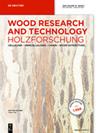用木质素热解产物替代苯酚的苯酚-甲醛树脂改性的苏格兰松树边材的抗真菌腐烂能力
IF 1.6
3区 农林科学
Q2 FORESTRY
引用次数: 0
摘要
苯酚-甲醛(PF)树脂可在原位浸渍和固化,以提高木材的尺寸稳定性和耐腐性。为了寻找可再生的替代品,人们讨论了用木质素裂解产物(LCP)替代苯酚。然而,不同的化学性质可能会影响树脂抗真菌腐烂、甲醛释放和平衡含水率的性能。在这项研究中,PF 树脂中 30%(重量/重量)的苯酚被微波辅助热解获得的 LCP 取代。用这种树脂对苏格兰松树边材进行改性。测定了该树脂对红豆杉(Rhodonia placenta)、Gloeophyllum trabeum 和 Trametes versicolor 的抗腐性。此外,还研究了试样在培养皿中的组织、不同基质、浸出时间和接种体类型的影响。此外,还测定了材料的水蒸气吸附特性和甲醛释放量。所有改良措施都有效地减少了真菌腐烂。在增重 10% 的情况下,可以检测到初步的腐烂,而增重 20% 和 30% 的情况下则可以提供有效的保护。苯酚替代物会增加甲醛释放量。虽然可能需要进一步降低树脂混合物或甲醛清除剂中的甲醛含量,但本文所述的方法可用于部分替代化石基苯酚,同时保持良好的抗真菌性。本文章由计算机程序翻译,如有差异,请以英文原文为准。
Resistance against fungal decay of Scots pine sapwood modified with phenol-formaldehyde resins with substitution of phenol by lignin pyrolysis products
Phenol-formaldehyde (PF) resins can be impregnated and cured in situ to improve the woods dimensional stability and decay resistance. In search of renewable alternatives, the substitution of phenol by lignin cleavage products (LCP) has been discussed. However, the different chemical nature may affect the performance of the resin against fungal decay, formaldehyde emission, and equilibrium moisture content. In this study, 30 % (w/w) of the phenol in PF resins were substituted by LCP obtained from microwave-assisted pyrolysis. Scots pine sapwood was modified with the resin. The decay resistance against Rhodonia placenta, Gloeophyllum trabeum , and Trametes versicolor was determined. Additionally, effects of specimen organisation within the Petri dish, different substrates, length of leaching, and type of inoculum were studied. Further, the materials water vapor sorption properties and formaldehyde emission were determined. All modifications effectively reduced fungal decay. With 10 % weight percent gain (WPG), initial decay was detected, while 20 % WPG and 30 % WPG provided efficient protection. The substitution of phenol increases the formaldehyde emission. While further reduction in formaldehyde in the resin admixture or formaldehyde scavengers may be required, the method described herein can be used to partly replace fossil-based phenol, while maintaining good fungal resistance.
求助全文
通过发布文献求助,成功后即可免费获取论文全文。
去求助
来源期刊

Holzforschung
工程技术-材料科学:纸与木材
CiteScore
4.60
自引率
4.20%
发文量
83
审稿时长
3.3 months
期刊介绍:
Holzforschung is an international scholarly journal that publishes cutting-edge research on the biology, chemistry, physics and technology of wood and wood components. High quality papers about biotechnology and tree genetics are also welcome. Rated year after year as one of the top scientific journals in the category of Pulp and Paper (ISI Journal Citation Index), Holzforschung represents innovative, high quality basic and applied research. The German title reflects the journal''s origins in a long scientific tradition, but all articles are published in English to stimulate and promote cooperation between experts all over the world. Ahead-of-print publishing ensures fastest possible knowledge transfer.
 求助内容:
求助内容: 应助结果提醒方式:
应助结果提醒方式:


